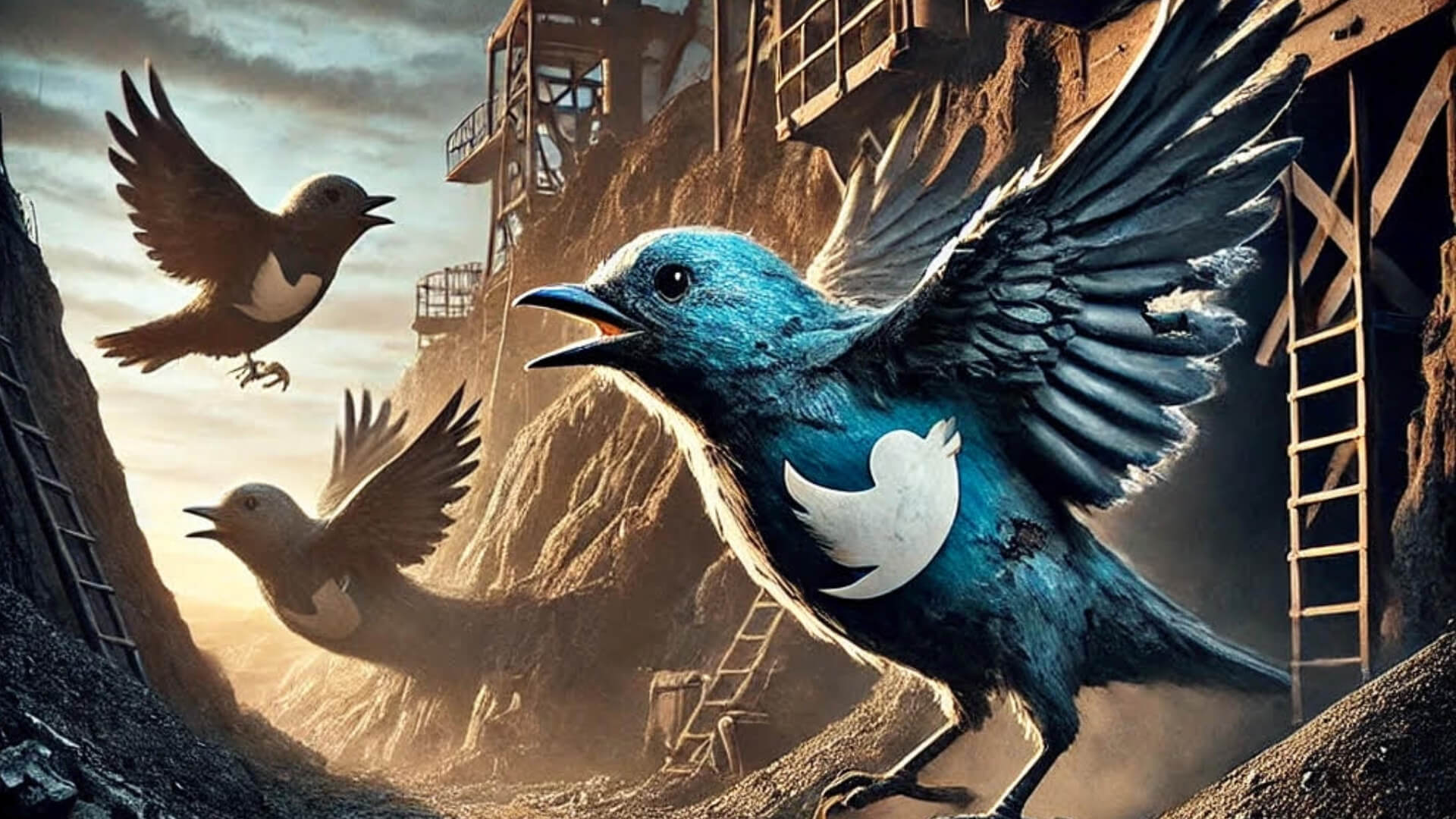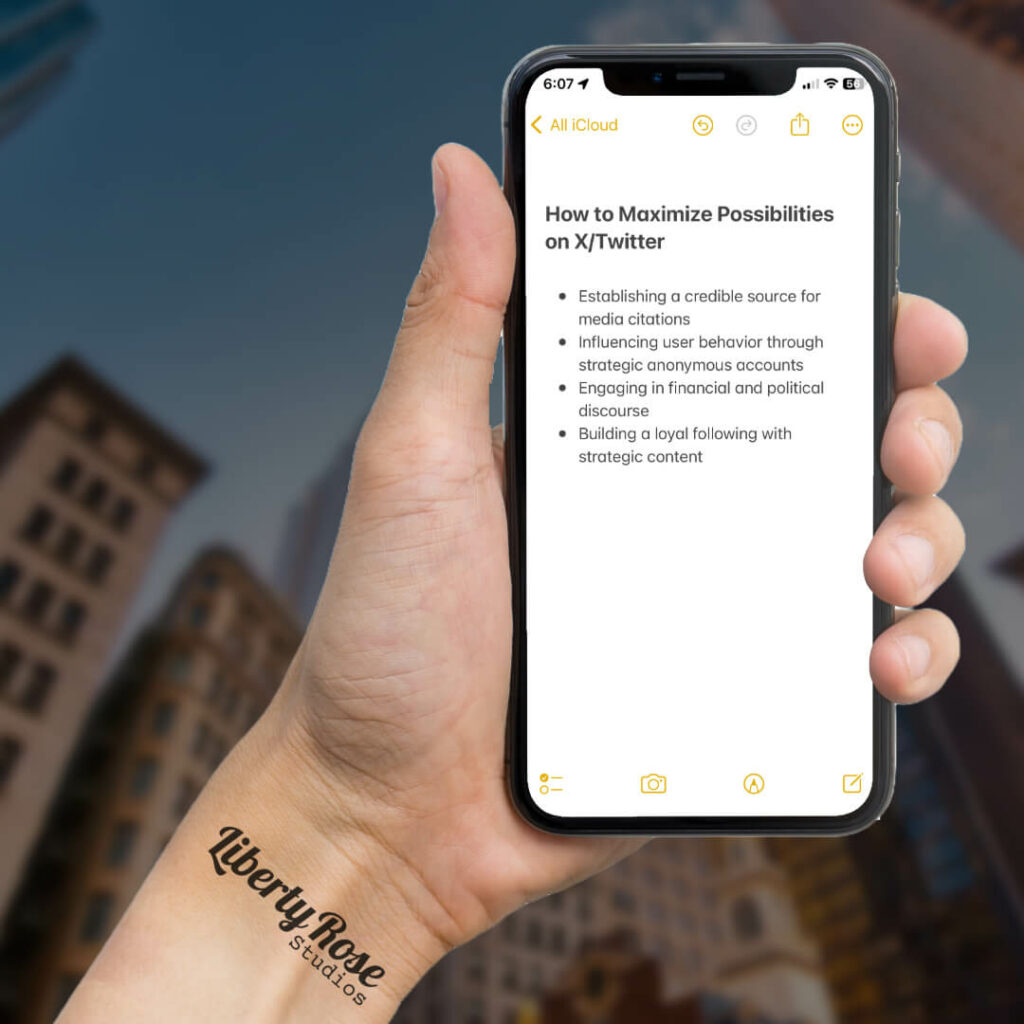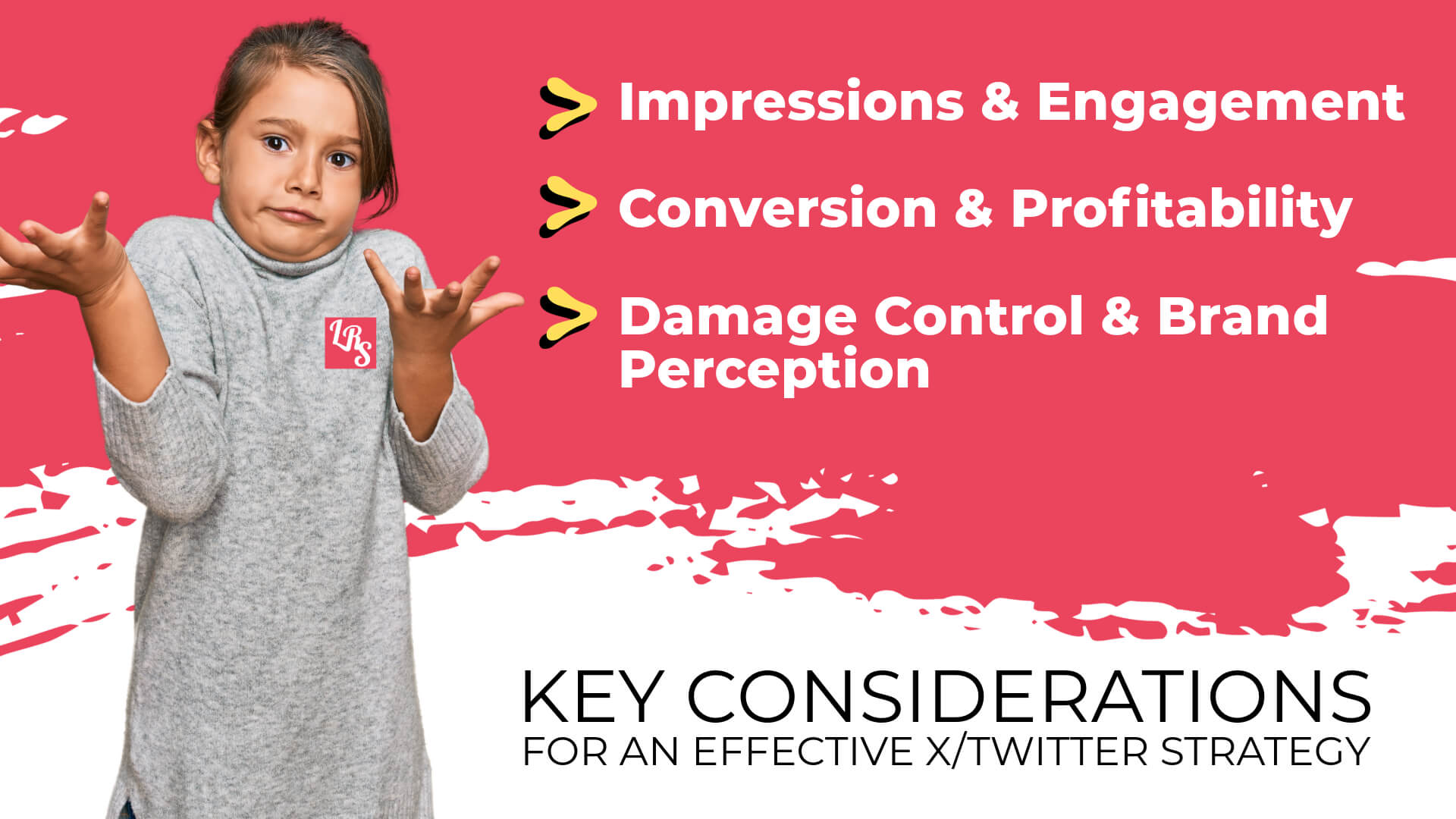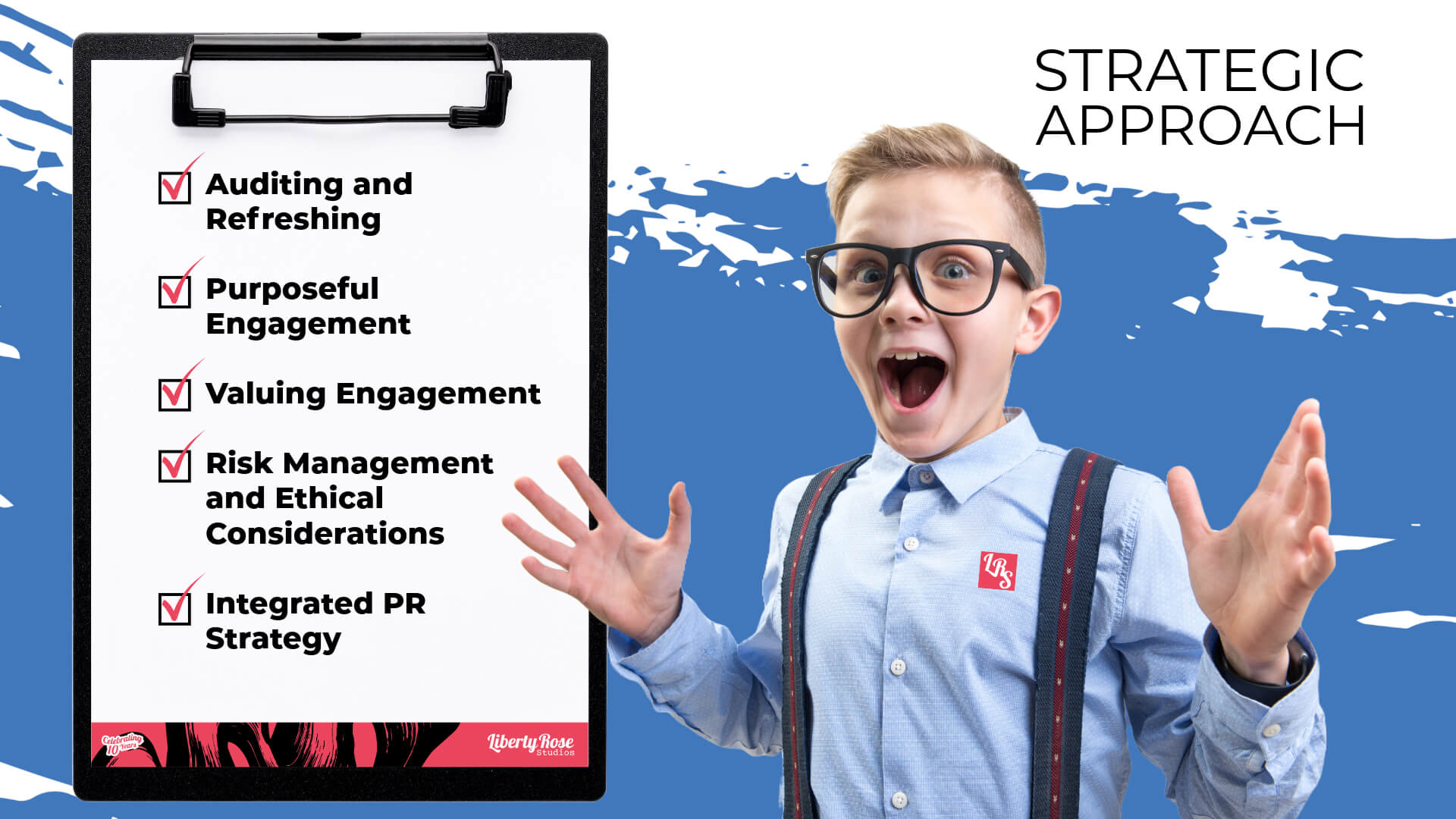
Canary, Meet Coal Mine…Again
Extracting Value From X (Twitter) In 2024

Written by Mattske // August 13, 2024 (Read Time: 13 Minutes)
SUMMARY
In the rapidly changing landscape of x (Twitter), Elon Musk’s legal battles with ex-advertisers highlight the platform’s challenges and potential pitfalls for brands. Despite its declining organic reach and controversial policies on spam, Twitter remains a key space for certain industries. Brands must navigate these complexities carefully, evaluating whether their presence on Twitter still aligns with their goals. Expert guidance can help brands make informed decisions about their Twitter strategies, focusing on authentic engagement, meaningful conversions, and ethical considerations. Whether revitalizing an existing Twitter account or choosing to disengage, the right approach ensures your brand can either thrive on the platform or find more fruitful opportunities elsewhere. With strategic support, you can harness or move beyond Twitter effectively for 2024 and beyond.
How To Not Make Friends & Still Influence People
In the wake of Elon Musk’s most recent stunt to attempt to court (pun intended) eX-advertisers back to his failed social media company, we felt it was important to share with our clients how companies can still succeed with whatever is left of X/Twitter. Rolling Stone writer Miles Klee gives a good primer on why this is unlikely to cause any real impact directly. Many people across various social media platforms including LinkedIn, have noted that there is no precedent or legal theory that would enable a judge to compel advertisers to spend money on a platform when they had no contractual obligation to do so. The crux of Musk’s complaint relates to the systematic departure, an exodus if you will, of paid advertising dollars from Twitter to literally anywhere else in the known universe. He is specifically suing the World Federation of Advertisers, as well as specific companies such as CVS & Unilever, claiming that they “illegally” colluded to withhold their advertising dollars from this social media company. The U.S. House of Representatives concluded in a very minimally researched report, that the restriction of advertising dollars from Twitter is also somehow connected to what they claim is the suppression of conservative voices on the platform.
Despite all of this, there are still an estimated 15,000,000 – 50,000,000 Americans who actively use Twitter, the platform is still cited all the time in news reports and broadcast stories, and it is heavily trafficked by people in finance, government, media, advertising, and other industries. However, the rules of the game have changed dramatically since Twitter was founded in 2006, and most people haven’t caught up.
The complexities and challenges of maintaining a successful Twitter presence can be daunting, and for some brands, the simple answer is, they just should delete their account and move on. But that is a question that must be asked seriously, questioned intelligently, and answered diligently. Liberty Rose Studios is uniquely positioned to help clients navigate these challenges and harness the power of Twitter (if appropriate) to achieve their business goals.
Understanding the Need for Brand Awareness and Action
Brands today need more than just visibility – they need actionable results. Our team helps clients generate brand awareness and track attributable actions to prove the effectiveness of any strategy. Something that people do not realize about how things have changed dramatically on Twitter relates to their newfound definition of spam. If you read the new terms & conditions (which too few people do) you will see that as of March 2023, Twitter now considers activity spam many different things. Most importantly for anybody who thought they could use Twitter to directly cause conversion on an ad campaign, is what they call “commercially-motivated spam.”
“commercially-motivated spam, that typically aims to drive traffic or attention from a conversation on X to accounts, websites, products, services, or initiatives”This is the death knell for organic activity on Twitter. The policy change may be positioned in such a way as to claim they are trying to protect people from unwanted spam, advertising for illegitimate purposes, or things of that nature. But in reality, any activity meant to drive traffic to a website (posted in tweets, comments, or on your profile) is labeled as spam, and could result in your account being suppressed or removed entirely. If you are paying the platform for advertising, they will allow you to drive traffic to your website in the context of your campaigns, sure. But the allure of social media has always been the notion that organic engagement is king. That simply isn’t true anymore, and this change in the terms & service proves that beyond a reasonable doubt. That game, is over.
Decoding X’s Operations
Despite other definitions of spam including, “inauthentic engagements, that attempt to make accounts or content appear more popular or active than they are,” this covers a vast amount of content that you will see in your feed. So long as you pay the platform, it demonstrates your commitment to keeping traffic on the site, which will ensure you are not classified as spam, no matter how inauthentic the engagement, and no matter how damaging the content. Even horrific, illicit media like child sex abuse material (CSAM) or extremist violence from all over the world spreads wildly on this platform, as a result of these accounts paying money to promote content using the same DIY ad platform that major brands do for their legitimate media.
Elon Musk vowed to clean up the “bot” problem on Twitter, but it is more rampant than ever. This occurs as a major problem for some brands, because they do not want their content to be placed next to disgusting or disturbing imagery. Some feel a moral obligation to remove themselves from this network, though without fully deleting an account, a brand still associates with the platform. Part of the thing about Twitter in particular, is that you can somewhat isolate yourself – if done so actively – to be quartered off in a safe(r) space. You do this by curating not only what accounts you follow and engage with, but also by curating your following. That is something which major brands have failed to do for over a decade, given the “more is better” mentality when it comes to building a large following.
The way your content is distributed, relates to both your following, and the internal search engine of Twitter, which means that if you have 500,000 followers, most of which are inauthentic accounts, you will inadvertently traffic in the same space as those. What you will find is that there are very few “transparent” accounts on this platform, where it is obvious the person operating the account is the same one whose face is represented in the bio. Also, there is no tool currently available to enable an account to clean up their follower list, to systematically block unwanted accounts.
These unwanted accounts create what we like to call an “attention vacuum” of sorts. It is made obvious by studying the number of impressions organic posts get, as a ratio of the total number of followers. In simple theory, you should be able to distribute your posts to all of your followers. For anybody who has been in social media for a while, you know that simply isn’t true. Most brands we have studied, large & small, struggle to even reach a 5% saturation of their following, which means that if you have 500,000 “followers,” your organic posts will reach no more than 25,000 impressions. Taking that a step further, an impression on Twitter is no longer defined as any specific number of seconds appearing on a screen. There is no way of knowing which accounts received this impression either, meaning you may well be receiving 0 actual attention.
Average cost per mil (CPM) aka 1,000 impressions, is about $5. That means, to compete with an account that has 500,000 followers, an account with basically 0 followers could achieve the same amount of attention for $125/per post. This is an analysis that few brands have done to determine the uselessness of their content on Twitter, but instinctively, many marketers have figured it out.
Maximizing Possibilities on Twitter
So, where is the good news? The potential of Twitter extends beyond mere engagement on their platform, because for better or worse, it still has some value.
If you’ve spent any amount of time on Twitter trying to get something to “go viral,” you will ultimately find that in order to do that, eventually you need publicity – for your content – to spread to news sites off the platform.

That requires a publicity strategy to engage with enough news agencies to actually cover your Twitter content. Otherwise you will notice that accounts regularly buy thousands or even millions of impressions but somehow don’t get recognized for it. That’s because they failed to use it as a citation for other media. Since Twitter also considers it spam (now) to drive traffic off their platform, you must do that on your own – outside of the platform – to achieve it.
Let’s say you’re a CPG brand that sells a snack product. You have a funny interaction with a user where you crack jokes back & forth. That will be engaging for some people who are following you, but mostly it will be invisible. If that story is sent to Business Insider, or a publicist who has press contacts at multiple outlets, you might find yourself receiving news for this story – which will inevitably drive more impressions and engagement on the Twitter post. But creating “viral” moments on Twitter alone will not generally yield you these results.
Our agency has been studying this platform for nearly (10) years, to figure out how it works, experimenting with a variety of types of accounts. We can help clients unlock these possibilities, guiding them to use Twitter as a powerful tool for influence and growth. But as the platform changes, it evolves. What worked in 2018 may not continue to work in 2024 and beyond. The things we have learned, though, are strategically valuable beyond individual tactics or formulas.
What has become obvious, is even the foremost experts who have run the worlds’ largest brands on Twitter are throwing their hands up right now with how to make an impact there, because what they’ve done no longer works.

Key Considerations for an Effective Twitter Strategy
1. Impressions and Engagement
We provide insights into the source and impact of Twitter impressions. That means instead of attempting to inflate results, we give you the cold hard reality of the situation, and help figure out what will drive actual impact. We evaluate engagement trends to ensure they align with conversion goals and mitigate potential damages.
2. Conversion & Profitability
Our strategy is to drive profitable traffic, distinguishing between engagement and genuine conversion. Too often agencies convince their clients that a campaign worked by showing metrics which are bloated by inauthentic accounts (that some agencies actually employ themselves) or suggesting that engagement on the platform caused results off the platform without attributing the traffic or conversion. If we find that conversion is not attributable from your Twitter activity, our suggestion would be to remove yourself from the platform or find another way to measure effectiveness.
3. Damage Control & Brand Perception
A lot of brands over the years have suffered from negativity on social media and Twitter is perhaps the most notorious in this domain. At this point, a lot of brands have restricted their time spent on the platform for that very reason. But you have to ask yourself if having a languishing account on a platform that you don’t want to engage with is doing damage to your brand by showing people you are inactive, or enhancing the notion that you are invisible.
Being boring on Twitter isn’t helpful. You have to figure out a place where you can hang out, have fun, and show off your brand’s personality on Twitter if you’re going to do it at all. That doesn’t mean you have to be rude, cruel, or hop on every trend. It does mean that you need to think carefully about what you’re trying to do, and how possible that even is.

Strategic Approach for 2024 and Beyond
1. Auditing and Refreshing
We will start with a comprehensive audit of your Twitter account, identifying bots, bad actors, and inactive followers. We will analyze your last few months of content to determine what trends are going on, and how well you are performing. It will provide you a sense of how to best use the budget you have, how to save money from wasteful spending, and look at how you fare compared to competitors. Once you have a firm understanding of your position on Twitter, and connect that to overall corporate goals, we can create a strategy that either you will manage or we can manage. Some clients may prefer to do a sort of “relay” whereby we share access to the account, publishing some content directly or writing things to be approved by your internal team. In certain cases, taking an active stance on the platform itself (meaning how it is run, and commenting about that) may be appropriate, especially for companies related to finance or other industries that are active on the platform.
2. Purposeful Engagement
We help define clear objectives for why your audience should engage with your brand on Twitter. If you can’t answer that question, the answer may be that they shouldn’t engage with you on Twitter. In fact, companies with gigantic budgets may do better if they invest their marketing dollars in promoting their own app, website, or other experiences where real value is found.
Our strategies are tailored to ensure meaningful engagement that aligns with your brand values and goals, rather than fitting you in on Twitter if you don’t belong there. There is no shame in admitting that the experiment of running a social media account failed to achieve all of the results you set out to achieve. Many celebrities and brands have generated solid publicity for deleting accounts or removing themselves from platforms like this, and that could be a potential strategy for you as well.
3. Valuing Engagement
We help you focus on nurturing existing relationships, creating a community of people on Twitter to share in media campaigns and with a cost-benefit analysis, we help you balance between paid advertising and organic content.
4. Risk Management & Ethical Considerations
We assess the risks of Twitter engagement, from resource wastage to potential negative publicity. Our strategies are mindful of broader societal impacts, ensuring your brand remains ethical and responsible.
5. Integrated PR Strategy
We will develop robust off-platform PR plans to complement your Twitter activities. Our approach includes continuous experimentation and learning from past successes and failures.
Learning To Fly Free As A Bird
Twitter offers potential for brand growth and engagement, but navigating its complexities requires expertise and strategic planning. Liberty Rose Studios is dedicated to helping clients not only survive – but thrive on Twitter. By leveraging our deep understanding of the platform and our tailored strategies, we ensure your brand stands out, engages meaningfully, and achieves its goals in 2024 and beyond.
Reach out to us to learn how we can transform your Twitter presence into a powerful tool for brand success.
